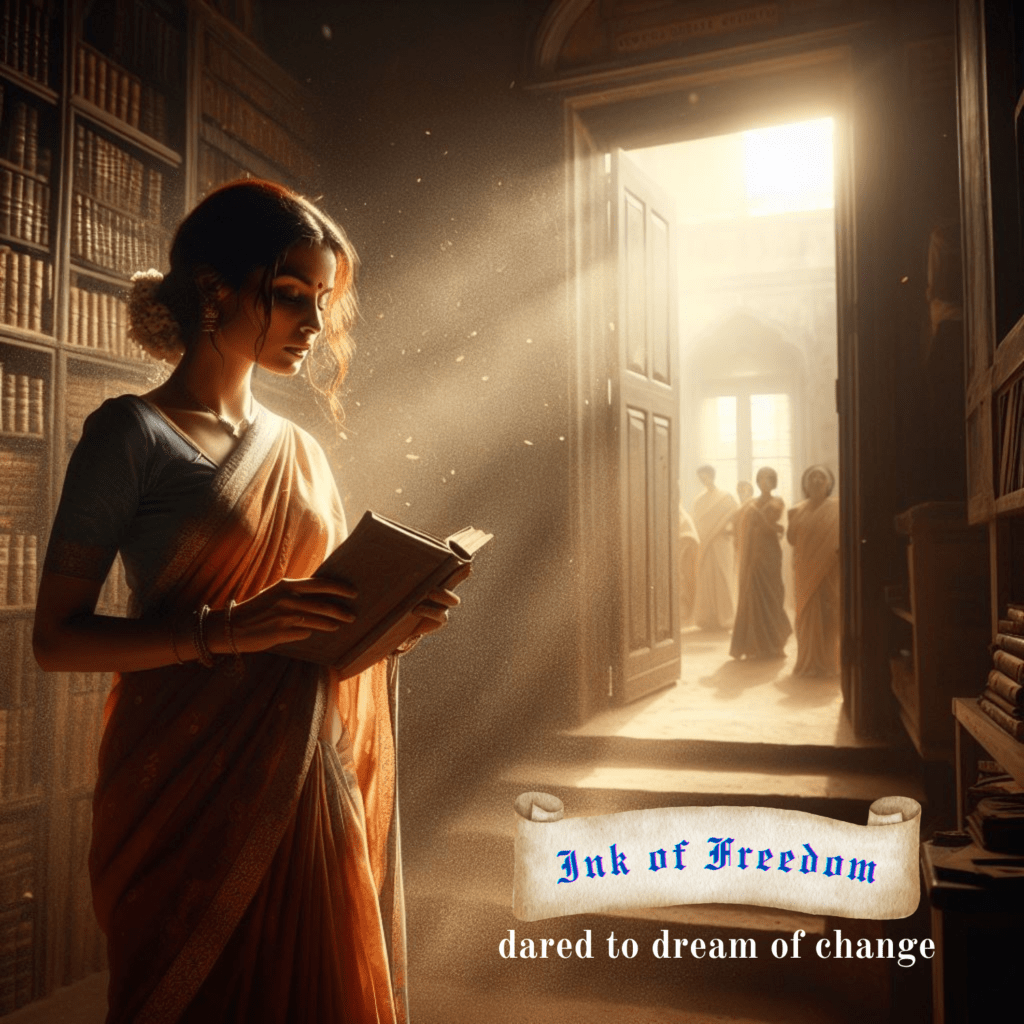
“In a village shrouded in tradition, one woman dared to dream of change.”
The summer sun beat down mercilessly on Sundarpur, turning the dusty village square into a shimmering mirage. Ananya Sharma, a wisp of a girl with defiance in her eyes, trudged back from the well, her clay pot balanced precariously on her head. Her gaze, however, wasn’t fixed on the dusty path; it was snagged on a crumbling building nestled amidst the labyrinthine alleys. It was the old library, a relic of a bygone era, its paint peeling like sunburnt skin, its windows boarded shut like sightless eyes.
Ananya had always felt drawn to this forgotten sentinel. Today, an irresistible urge propelled her towards it. Ignoring the scorching heat, she pushed open the creaking gate, a symphony of dust motes dancing in the shaft of sunlight that pierced the gloom. Inside, the air hung heavy with the scent of forgotten dreams. Books, their pages brittle and yellowed, stood like silent soldiers on rickety shelves. Cobwebs draped the furniture like ghostly shrouds, and a broken globe lay on the floor, its continents fractured like shattered hopes.
Ananya felt a pang in her chest, a strange mixture of sorrow and inspiration. This library, with its stories imprisoned, mirrored the fate of many women in Sundarpur, confined by tradition and illiteracy. But amidst the decay, a seed of hope bloomed in Ananya’s heart. She envisioned this space transformed, not just a repository of dusty tomes but a vibrant community center, a beacon of knowledge and empowerment.
With burning determination, Ananya set about cleaning the library. Days bled into weeks as she painstakingly scrubbed floors, dusted shelves, and mended broken furniture. The village elders watched with a mix of amusement and disapproval. “Why waste your time, Ananya?” they scoffed. “Women’s duty lies at home, not in books.” But Ananya wouldn’t be deterred. She knew that education was the key to breaking free from the shackles of tradition, for herself and the women of Sundarpur.
One afternoon, as Ananya was rearranging the books, a group of women, emboldened by her quiet resolve, cautiously approached the library. Ananya’s heart soared. She shared her vision with them, her voice trembling with passion. “Imagine,” she said, “a place where you can learn to read and write, where you can discover new worlds and dream beyond the walls of your homes.” Her words resonated. The spark of curiosity ignited in their eyes, mirroring the newfound light in the library.
Together, they cleaned, repaired, and organized. The once-forsaken space began to hum with activity. The day of the grand reopening dawned bright and hopeful. Women, adorned in their colorful sarees, gathered in the library, their faces etched with anticipation. Ananya, her voice clear and strong, unveiled her plans – literacy programs, vocational training workshops, and most importantly, a platform for women to share their stories and aspirations.
As weeks turned into months, the library transformed. Women, young and old, gathered to learn. They stumbled through their first alphabets, their faces creased in concentration, their eyes shining with newfound determination. Workshops buzzed with discussions on financial literacy, health care, and self-defense. The library became more than just a building; it became a sanctuary, a space where women could shed their inhibitions and learn to fly.
Slowly, attitudes in Sundarpur began to shift. The once-skeptical elders watched in awe as women emerged from the library, their eyes filled with knowledge and confidence. Young girls, inspired by Ananya’s dedication, started dreaming of a future beyond the confines of their homes. The library, once a symbol of forgotten dreams, became a testament to the collective power of women, proving that even in the most parched landscapes, resilience and determination can blossom into change.
Ananya, forever changed by her journey, watched from the sidelines, a satisfied smile gracing her lips. She knew her work was far from over, but the seeds of change had been sown, and the ink of freedom flowed freely in the hearts of the women of Sundarpur.
The news of Sundarpur’s transformation spread like wildfire. From neighboring villages, women, yearning for a taste of education and empowerment, began arriving at Ananya’s doorstep. The library, once meant to serve a single village, became a beacon for the entire region. Ananya, her leadership blossoming, established a network of women leaders across villages, each taking charge of their local libraries and workshops.
However, the winds of change often face resistance. A powerful landlord, threatened by the empowered women who started questioning his exploitative practices, attempted to shut down the libraries. He used his influence to spread rumors, claiming that education would corrupt women and destroy traditional values. Fear gripped some villagers, and attendance started to dwindle.
Undeterred, Ananya and the women leaders embarked on a campaign to counter the propaganda. They organized street plays, where they enacted stories of empowered women who fought for their rights and improved their lives through education. They invited doctors and successful entrepreneurs to speak about the benefits of education and self-reliance. Slowly, the tide began to turn.
One day, a group of women, armed with the knowledge they gained from the library, approached the local council and presented a petition demanding fair wages for agricultural work. The men on the council, accustomed to their subservient role, were taken aback. But the women, their voices strong and their arguments logical, refused to back down. After much deliberation, the council agreed to their demands, marking a historic victory for the women of Sundarpur and its surrounding villages.
News of their success spread far and wide. Soon, government officials, impressed by Ananya’s initiative and the positive impact it had on the community, approached her. They offered her funding and support to expand the library network and establish vocational training centers that would equip women with marketable skills.
Ananya, ever the pragmatist, accepted the help but ensured that the ownership and leadership remained with the women themselves. The organization, now christened “Stree Shakti [ स्त्री शक्ति ]” (Women’s Power), grew into a formidable force. Women not only learned to read and write but also became skilled artisans, entrepreneurs, and even community leaders.
Years later, Sundarpur stood transformed. The once-dusty village square was now a vibrant marketplace, bustling with women selling their wares. The library, now a sprawling complex, housed not just books but also computer labs, skill-development workshops, and a daycare center. Ananya, her hair streaked with silver but her eyes still burning with purpose, watched with pride as a young girl, her daughter perhaps, confidently took her first steps into the library, ready to embark on her own journey of empowerment, armed with the ink of freedom.
Celebrate Women’s Day with an inspiring short story in English, perfect for bedtime reading. “Ink of Freedom” is a captivating tale of resilience and empowerment, ideal for adults seeking motivational stories. Join us on this National Women’s Day as we honor the strength and courage of women worldwide. Dive into this free short story, a true gem among inspirational books, and feel the spirit of Lady Day come alive.
Indulge in short bedtime stories for adults and uplift your spirits with “Ink of Freedom.” This motivational story in English offers a powerful message of hope and determination, making it one of the best short stories to read on Women’s Day. Let this inspiring tale touch your heart and remind you of the importance of empowerment and equality. Happy International Women’s Day!









Hi i think that i saw you visited my web site thus i came to Return the favore Im attempting to find things to enhance my siteI suppose its ok to use a few of your ideas